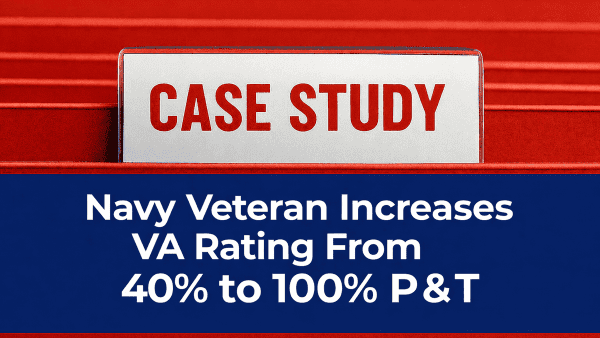Looking for Expert-Level VA Claim Answers?📱Call Us Now! 737-295-2226
If you live with tension headaches, you know they’re more than just an average headache. The constant pressure, tightness, and pain can drain your energy, interfere with your work, and limit daily life.
The VA recognizes tension headaches as disabling, but because they’re rated under the same code as migraines, getting the correct VA rating can be confusing.
In this guide, we’ll break down how the VA rates tension headaches, the different ways to prove service connection, and what steps to take when filing your VA disability claim.
Table of Contents
Summary of Key Points
- Tension headache VA ratings can be 0%, 10%, 30%, or 50%, under the diagnostic code for migraines (DC 8100).
- VA ratings for tension headaches depend on how often you experience prostrating attacks, how severe they are, and whether they interfere with your ability to work or manage daily life.
- You can qualify for service connection for tension headaches directly, secondarily (linked to another service-connected condition), or by aggravation.
What are Tension Headaches?

Tension-type headaches are the most common kind of headache, causing dull, pressure-like pain around the head or neck.
They can be infrequent or frequent episodic (lasting 30 minutes to a week, fewer than 15 days a month) or chronic (15 or more days a month for at least three months).
Unlike migraines, tension headaches usually don’t come with nausea, vomiting, or visual changes, and physical activity typically doesn’t make them worse.
In veterans, tension headaches often stem from stress, anxiety, or muscle strain related to military service. They can also be linked to head injuries or post-traumatic conditions.
Tension Headache VA Ratings
There is no specific diagnostic code (DC) for tension headaches. Instead, the VA rates tension headaches under the same DC as migraines (DC 8100), with potential ratings of 0%, 10%, 30%, or 50%.
- 50% VA Rating: With very frequent, completely prostrating, and prolonged attacks, productive of severe economic inadaptability
- 30% VA Rating: With characteristic prostrating attacks occurring on average once a month over the last several months
- 10% VA Rating: With characteristic prostrating attacks averaging one in 2 months over the last several months
- 0% VA Rating: With less frequent attacks
Note: “Prostrating” means “causing extreme exhaustion, powerlessness, debilitation, or incapacitation with substantial inability to engage in ordinary activities.”
Related: Explore our Guide to the New VA Ratings for Migraine Headaches
Proving Service Connection for Tension Headaches
It’s possible to prove service connection for your tension headaches through direct service connection, secondary service connection, or aggravation.
Here’s a breakdown of all three types of service connections.
Direct Service Connection
Direct service connection for tension headaches means that something that happened during service directly caused your condition.
For example, if you experienced a head injury or long-term exposure to extreme stress during deployment and later developed tension headaches, that incident may qualify for direct service connection.
To qualify for direct service connection, you’ll need:
- A current diagnosis of tension headaches
- An in-service event, injury, aggravation, or illness
- A medical nexus (link) between your current diagnosis and the in-service event, injury, aggravation, or illness
Secondary Service Connection
Secondary service connection means another service-connected condition caused your tension headaches.
For example, if you’re already service-connected for PTSD, anxiety, or chronic neck pain, and those conditions trigger or worsen your tension headaches, you may qualify for a secondary claim.
Service Connection by Aggravation
Pre-existing tension headaches that are made worse by a service-connected condition may qualify for service connection via aggravation.
For example, if you experienced occasional headaches before enlistment but developed chronic, more severe tension headaches because of a service-connected injury or condition, you could file for service connection by aggravation.
(VIDEO) How to File a VA Claim Online!
C&P Exam for Tension Headaches
A compensation and pension (C&P) exam for tension headaches evaluates your current diagnosis, service connection, and the frequency and severity of your episodes.
During the exam, be prepared for a basic physical and to explain how your tension headaches affect your daily life, work, and overall well-being. Clear, specific details can strengthen your claim.
Pro Tip: Not all VA claims require a C&P exam, but if the VA schedules one, attending is crucial. Skipping it could delay or leave your claim lacking key evidence that may strengthen your case.
See More: How Do I Know if My C&P Exam Went Well?
Conclusion
Tension headaches may not always show up on a scan or test, but the impact is real. The VA recognizes that tension headaches can seriously affect daily life. With a current diagnosis and clear documentation linking your condition to service, you may strengthen your claim and improve your chances of securing the VA compensation and benefits you deserve.
Want Expert-Level Support for Your VA Disability Claim? WE GOT YOUR SIX!

- VA Claims Insider is the #1 most trusted name in VA disability claims.
- Work directly with a VA claims coach who can educate you through the claims process.
- 25,000+ disabled veterans have served in our membership programs since 2016.
- 30% average rating increase for veterans who complete our #1-rated Elite program.
- 4.7/5.0 average rating out of 5,500+ total reviews; over 4,500 5-star reviews.
(FAQs) Frequently Asked Questions
What is the tension headache VA rating?
The VA rates tension headaches under the same diagnostic code as migraines, Diagnostic Code (DC) 8100. Ratings range from 0% to 50%, based on how often you experience prostrating attacks, how severe they are, and how much they interfere with your ability to work or carry out daily activities.
Why are tension headaches rated under the migraine code (DC 8100)?
The VA does not have a specific diagnostic code for tension headaches, so they are rated by analogy under the migraine code, Diagnostic Code (DC) 8100. This allows the VA to evaluate tension headaches using the same rating criteria as migraines—0%, 10%, 30%, or 50%—based on the frequency, severity, and impact of prostrating attacks on a veteran’s work and daily life.
Are tension headaches related to PTSD?
PTSD, anxiety, and other mental health conditions can trigger or worsen tension headaches. If you’re service-connected for PTSD, you may be able to claim your tension headaches as a secondary condition.
What are the secondary conditions to tension headaches?
Tension headaches can lead to or worsen other conditions that may also qualify for VA disability. Common secondary conditions include sleep disturbances, anxiety, depression, and musculoskeletal pain caused by chronic head and neck tension. If these conditions are linked to your service-connected tension headaches, they can be claimed separately and may increase your overall combined VA rating.
Are tension headaches presumptive under the PACT Act?
No. Tension headaches are not considered a presumptive condition under the PACT Act. You’ll need to prove direct service connection, secondary connection, or aggravation.
Can you get a 100% VA rating for tension headaches?
The maximum schedular rating for tension headaches is 50%. Still, if they prevent you from securing and maintaining substantially gainful employment (in addition to meeting the specific requirements), you may qualify for Total Disability Individual Unemployability (TDIU), which pays at the 100% rate.
Author

Kelly Olone
Kelly Olone is a military spouse who earned her degree in Psychology from Florida International University. After working in the non-profit sector for several years, she turned to her passion for writing. She aims to contribute to a better understanding of the valuable benefits that veterans deserve. As a mom, Kelly navigates the delicate balance between deadlines and bedtime stories with finesse.



